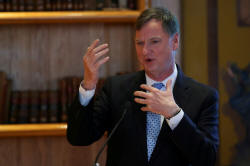Fed policymakers start penciling in earlier U.S. rate hikes
 Send a link to a friend
Send a link to a friend
 [November 19, 2021] (Reuters)
- Federal Reserve policymakers are
penciling in the possibility of earlier interest rate hikes than they
thought would be needed just a few months ago, as inflation continues to
soar and the economy picks up speed. [November 19, 2021] (Reuters)
- Federal Reserve policymakers are
penciling in the possibility of earlier interest rate hikes than they
thought would be needed just a few months ago, as inflation continues to
soar and the economy picks up speed.
The shift comes as President Joe Biden nears a decision on whether to
keep Jerome Powell as Fed chair for another term, or to elevate Governor
Lael Brainard to that post instead. Earlier this week Biden signaled he
could make an announcement on Friday.
Whoever Biden picks will face the thorny task of steering toward the
Fed's two goals, stable prices and full employment, when they appear to
be increasingly in conflict.
Both Powell and Brainard have said they believe the current inflation
surge will subside next year as supply chains are repaired, and have
argued the Fed should keep interest rates at rock bottom to give more
time for the millions of Americans who lost employment or left the
workforce during the pandemic to get a job if they want to.
Many of their Fed colleagues have signed on to that view, but continued
rising prices are challenging it.
On Thursday, one of the U.S. central bank's most reliable policy doves
said he is "more open-minded" to raising interest rates next year than
he was six months ago. A 2022 interest rate hike, Chicago Fed President
Charles Evans said, could be appropriate if inflation continues to stick
despite his expectations to the contrary.=

"I wouldnít describe it as hair on fire or anything like that," Evans
told reporters after a talk. "But I would say, I have to admit, itís
gone on longer, things are not quite as clean as I was hoping for;
patience is hard, and there might be a little bit of movement sooner
than I'm thinking, or it could be that I'm just flat out wrong and we
need to move."
Separately, Atlanta Federal Reserve President Raphael Bostic said he
believes the U.S. central bank could start raising interest rates in the
middle of next year, based on the jobs outlook.
[to top of second column] |

Chicago Federal Reserve Bank President Charles Evans speaks during
the Global Interdependence Center Members Delegation Event in Mexico
City, Mexico, February 27, 2020. REUTERS/Edgard Garrido

"Right now, our projections suggest that by the summertime of next year, the
number of jobs that we have in the economy will be pretty much where we were
pre-pandemic," Bostic said in an interview with NPR's Marketplace. "And at that
point, I think itís appropriate for us to try to normalize our interest rate
policy."
Bostic previously said he was among the half of Fed policymakers who, as of
September, thought a rate hike would be appropriate by next year, but his public
embrace of a mid-2022 liftoff is new.
At their policysetting meeting last month, Fed officials decided to begin
withdrawing support for the economy by gradually reducing what had been $120
billion in monthly asset purchases down to zero by next June.
Some policymakers have since called for a hawkish turn and a quicker taper so as
to position the Fed for an even earlier rate hike should it be needed.
Evans pushed back on that view on Thursday. "The expectation is we don't raise
rates before (the end of the taper); the expectation is we don't adjust (the
taper) unless, state-contingent, we see a big change in the data," he said.
But traders are already adjusting their expectations, with interest-rate futures
now pricing in a better-than-even chance of three rate hikes before the end of
next year.
In September only half of the Fed's policymakers thought they would need to
begin to raise rates next year, with the other half seeing 2023 as more likely
for the first rate hike.
The Fed will deliver a better read on how far policymakers' views may have
shifted when it releases fresh quarterly forecasts on Dec. 15, when its next
policymaking meeting wraps up.
(Reporting by Ann Saphir; Editing by Leslie Adler)
[© 2021 Thomson Reuters. All rights
reserved.] Copyright 2021 Reuters. All rights reserved. This material may not be published,
broadcast, rewritten or redistributed.
Thompson Reuters is solely responsible for this content. |